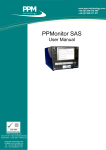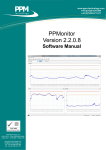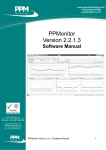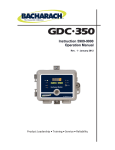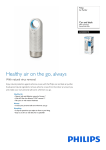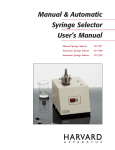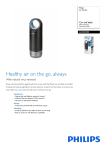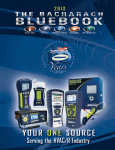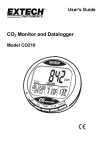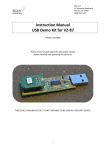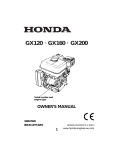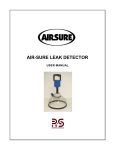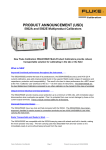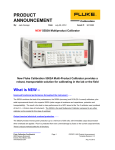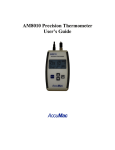Download Wireless IAQ Profile Monitor
Transcript
www.ppm-technology.com Tel: +44 (0)1286 676 999 Fax: +44 (0)1286 671 811 www.ppm-technology.com +44 (0)1286 676 999 +44 (0)1286 671 811 Wireless IAQ Profile Monitor User Manual PPM Technology Ltd Units 34-35 ᵒ Cibyn Industrial Estate Caernarfon ᵒ LL55 2BD ᵒ Wales, UK www.ppm-technology.com [email protected] Tel: +44 (0)1286 676 999 Fax: +44 (0)1286 671 811 PPM Technology Wireless IAQ Profile Monitor - User Manual 1 Contents This user manual should be used in conjunction with the PPMonitor User Manual. Contents...............................................................................................................2 1 Introduction.....................................................................................................3 1.1 Initial receipt of the PPM Wireless System.............................................3 2 Hardware.........................................................................................................4 2.1 Wireless IAQ Monitor.............................................................................4 2.2 ZigBee Wireless USB Dongle.................................................................5 3 Wireless network.............................................................................................6 4 Maintenance....................................................................................................8 4.1 Mounting the Wireless IAQ Monitor.......................................................8 4.2 Testing the formaldehyde calibration.......................................................8 4.3 Formaldehyde calibration test frequency...............................................11 5 Warranty........................................................................................................12 PPM Technology Wireless IAQ Profile Monitor - User Manual 2 1 Introduction NOTE: PPM Technology will not be held liable for errors that may appear herein or for incidental or consequential damages in connection with, or arising from the use of this material or provided equipment. NOTE: If you find any items damaged upon delivery, please report this to both the carrier and your dealer. This user manual covers the set up and use of the PPM Wireless IAQ Profile Monitor units. The PPMonitor system is very simple to set up and to use, however, it is important to read these instructions and familiarise yourself with the system before turning the unit on. 1.1 Initial receipt of the PPM Wireless System Your PPMonitor Wireless system has been carefully packaged and contains all the necessary components for full operation. Upon delivery of the system, please ensure all ordered items are present and in good condition. Any problems should be reported to your dealer. Your network can be made up of a variety of units, including: • Wireless IAQ Profile Monitor • Mini Wireless IAQ Profile Monitor ◦ Mini IAQ ¢£¤ ◦ Mini IAQ Sensor ◦ Mini IAQ Temperature and Humidity * The ZigBee dongle is only provided as standard on the first purchase, since only one dongle is required per network. Additional dongles may be purchased from PPM Technology if required. ◦ Mini IAQ Alarm You will also be provided with a wireless ZigBee dongle* which should be connected to your control PC. This should already be configured as the master of your network. The PPMonitor software is provided on a CD and instructions on its use can be found in the PPMonitor Software Manual. PPM Technology Wireless IAQ Profile Monitor - User Manual 3 2 Hardware 2.1 Wireless IAQ Monitor IAQ MiniIAQ 12V DC, 2.5mm jack plug Mains power: Operating range: Dimensions (mm): Sampling rate: 0-45ºC, 15-90%RH 240x240x55 Up top 7 parameters once a minute Wireless IAQ Monitor * NOTE: The table is correct as of 17/06/2011. There may be changes in specification following this date and, as a result, an updated revision of the manual. 145x145x55 Up to 5 parameters once a minute Mini Wireless IAQ Monitor The Wireless IAQ Profile Monitors are available in multiple configurations, and the sensors contained in them vary depending on the type of unit. IAQ Mini IAQ ¢£¤ Mini IAQ Sensor Mini IAQ Temperature and Humidity Mini IAQ Alarm Formaldehyde Temperature sensor and humidity ✓ ✓ Additional sensors 4 Relays 3 x ✓ ✓ x 3 2 x x ✓ x x x ✓ x 3 ✓ PPM Technology Wireless IAQ Profile Monitor - User Manual 4 2 Hardware There are many sensor options available for the Wireless IAQ Monitor. This list includes some options available: NOTE: The sensor list is not exhaustive, and the options available are potentially limitless. There are also nonair quality related sensors available, including noise, vibration, airflow, flood and movement. The system can be adapted to gather information from any 4-20mA current input, 0-5V input or serial input. The values represented in the table are typical values and may not reflect the sensors in your unit. This information can be found in the calibration certificate. * Extended range available on request. ** Formaldehyde readings meet the NIOSH criteria for acceptability when measuring 0.3ppm formaldehyde over a relative humidity range of 25 – 70%. NOTE: Sampling at high concentrations for prolonged periods may limit the lifespan of the sensor. More information on this is available by contacting PPM Technology. Range 0-10ppm* -40ºC - +128ºC 0-100% Accuracy ** 0.3ºC 1.80% Resolution 0.01ppm ±0.03ºC 0.03% Repeatability 2.00% ±0.1ºC 0.10% 0-10ppm 0-100ppm - 0.01ppm 0.1ppm - 0-5000 ~0-20ppm - 1ppm 0.01ppm - ~0.1ppm - <0.02ppm - SO2 0-100ppm - <0.1ppm - CH4 0-5%vol 50-1500ppm - 0.05%vol - 0-100ppm - <1ppm - 0-20ppm - <0.02ppm - HCHO Temp Humid NO2 CO CO2 TVOCs O3 R22 NH3 Cl2 The sensors within the Wireless IAQ Profile Monitor sample the air mainly by augmented diffusion, whereby air flow is not forced by a pump. A low volume fan is instead used to help maintain air flow. This method is preferred by PPM Technology because it gives a more accurate representation of the surrounding air since sufficient time is allowed for molecules to diffuse evenly, and it prolongs the life of the sensor – a pump would dry out the sensor at a much faster rate. 2.2 ZigBee Wireless USB Dongle This manual contains all the necessary information on using the ZigBee dongle in the PPM wireless system. If more information on this hardware is required, please contact PPM Technology. PPM Technology Wireless IAQ Profile Monitor - User Manual 5 3 Wireless network NOTE: For locations where an extended range, but no data recording is required, dedicated repeater nodes or power-amplified units are available. NOTE: The 2.4GHz band is shared with Wi-Fi and Bluetooth signals. Despite this, there is no interference between these technologies. On powering up, the Wireless IAQ Monitor units will scan the spectrum for any existing signals. After doing so, the unit will select the quietest channel to transmit on. This process of adjustment works continuously, and the channels will be changed as other signals begin transmitting. The ZigBee wireless system allows many different wireless network configurations. Wireless IAQ Monitor units act as a relay and create an ad-hoc mesh network. A unit only needs to be close enough to another unit to transfer data, and the network's range is effectively extended with each unit that is added. Here is an example of a typical mesh network in use at an office: Notice the thicker supporting wall at the bottom centre of the diagram. This wall is blocking the signal, and as a result, repater nodes have been placed to carry the signal around the obstruction. Typical examples of signal obstructions include thicker walls, metallic walls/doors (e.g. Garage doors), metal meshes etc. PPM Technology Wireless IAQ Profile Monitor - User Manual 6 3 Wireless network The ZigBee network is self-healing. In the event of a problem with a unit or a signal obstruction, the system will automatically re-route the signal, as seen in the example below: The master node of the mesh network is the ZigBee wireless USB dongle. To use the dongle, the appropriate driver should be installed (see PPMonitor software manual). Once the driver has been installed, simply inserting the Telegesis stick into a free USB port is sufficient. Once the PPMonitor software runs, it will automatically find the Wireless IAQ units within your network. NOTE: The PPMonitor Installer gives you the option to include the driver for the USB dongle. If you have selected this during the install, the USB dongle should get found automatically. PPM Technology Wireless IAQ Profile Monitor - User Manual 7 4 Maintenance 4.1 Mounting the Wireless IAQ Monitor There are two ways of mounting the Wireless IAQ Monitor. The easiest method is to use the supplied bracket and slide the unit onto it, as pictured below. It is also possible to attach the units to any Standard VESA attachments (such as wall brackets). To do this, simply remove the mount screws at the back of the unit and remove the mount, which can be replaced with another VESA mounting interface. The Wireless IAQ Monitors can be attached to a VESA MIS-D 100 mount, while the Mini Wireless IAQ Monitors can be attached to a VESA MIS-D 75 mount. 4.2 Testing the formaldehyde calibration NOTE: For accurate results, please ensure that the calibration standard has not passed its expiry date or 100 uses (whichever comes first). The accuracy of the readings cannot be guaranteed once the calibration standard has expired. Replacement Calibration Standards can be purchased from PPM Technology or your distributor. To ensure accurate results from the Wireless IAQ Monitors, it is important to test its calibration. Performing a calibration test is simple, and should only take 1-2 minutes. Before performing the test, make sure the PPMonitor services are running and recording data. To perform a calibration you will need a Formaldehyde Calibration Standard and a short length of PVC tubing. The Calibration Standard should then be placed in the same location as the Wireless IAQ Monitor for at least 1 hour to equilibriate to the same temperature. While handling the Calibration Standard, you should only touch the yellow end caps of the tube. PPM Technology Wireless IAQ Profile Monitor - User Manual 8 4 Maintenance First, remove the end plugs from the Calibration Standard. Locate the inlet for the formaldehyde sensor and attach the length of tubing. Place the Calibration Standard onto the inlet. While doing this, ensure the Calibration Standard is oriented correctly acording to the arrows on the label. PPM Technology Wireless IAQ Profile Monitor - User Manual 9 4 Maintenance Once the Calibration Standard has been placed, keep it in this position until the formaldehyde sensor has taken a reading (indicated by the sound of a pump). Once this has occured, you can remove the Calibration Standard and, replace the end caps and store the standard. To check the reading for the calibration test, doubleclick the formaldehyde graph on your control PC to get the expanded graph view. There should be a peak in the readings on the graph. If no peak is present, wait a few minutes and refresh the screen. Temperature ºC ºF 15 59 16 61 17 63 18 64 19 66 20 68 21 70 22 72 23 73 24 75 25 77 26 79 27 81 28 82 29 84 Formaldehyde (ppm) Minimum Maximum 1.25 1.39 1.36 1.50 1.47 1.63 1.60 1.76 1.73 1.91 1.86 2.06 2.02 2.24 2.19 2.42 2.37 2.61 2.56 2.82 2.76 3.06 2.99 3.31 3.24 3.58 3.51 3.87 3.80 4.20 Place the cursor over the peak to get the formaldehyde levels. After gaining this reading, check the temperature reading from the same unit. Once you have both readings, you can consult the table to the left. To pass the calibration test, the formaldehyde value should fall between the minimum and maximum values for the corresponding temperature. PPM Technology Wireless IAQ Profile Monitor - User Manual 10 4 Maintenance 4.3 Formaldehyde calibration test frequency A calibration test for formaldehyde is advised upon receipt of a new Wireless IAQ Monitor or fuel cell. NOTE: Calibration checks should be performed more frequently when you are monitoring high formaldehyde levels. If you are unsure how often you should check the calibration, contact PPM Technology or your distributor. Formaldehyde Calibration tests should initially be performed every two weeks for the first two months. Once two months has elapsed, we recommend that you compare all the calibration test results. If there is no significant drift to the readings and the unit still passes the calibration test, you can decrease the frequency of the test to once a month. If there is significant drift or the unit fails a calibration test, you should continue as previously and test the calibration every two weeks. Failure of a calibration test means a unit requires recalibration, and you are advised to contact us in this case. PPM Technology Wireless IAQ Profile Monitor - User Manual 11 5 Warranty The PPMonitor SAS is warranted to be free of defects in material and workmanship under proper and normal use and service for a period of 1 year from the date of purchase. This warranty is limited to repair or replacement (at our option) of any part that proves defective in material or workmanship under normal use and service, provided the product is returned to PPM Technology Limited, shipment charges prepaid. Damage due to defacement, misuse, tampering, lack of prescribed maintenance or use in violation of the instructions furnished by PPM Technology Limited is not covered. This warranty is in lieu of all other warranties, express or implied, including but not limited to merchantability or fitness for a particular purpose. In no event shall we be liable for any incidental or consequential damages of any nature. PPM Technology Limited reserves the right to make changes at any time to this document and to the design, construction, appearance and specifications of its products without notice. No part of this document may be reproduced in any form without prior consent of PPM Technology Limited. PPM Technology Wireless IAQ Profile Monitor - User Manual 12













